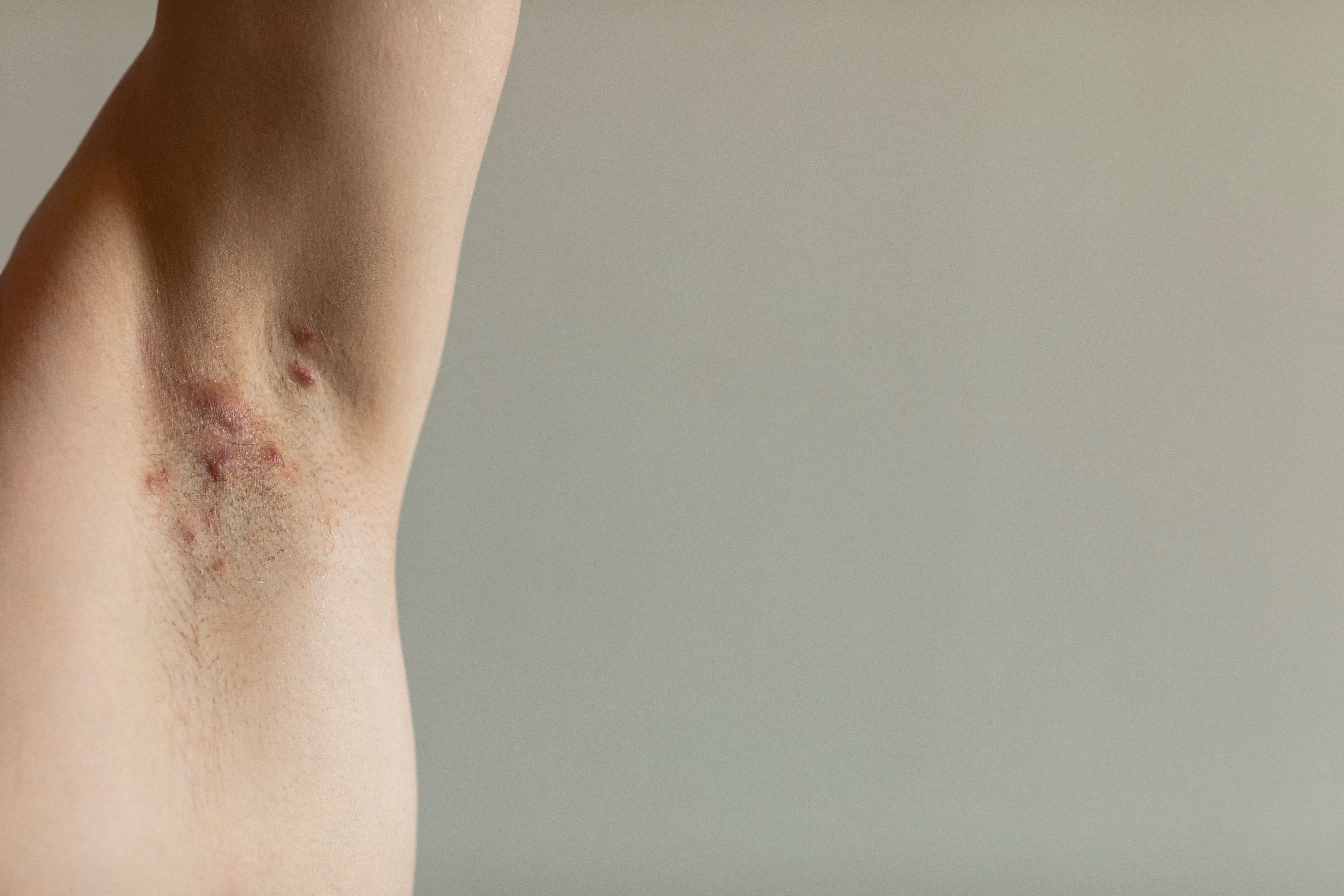- Case-Based Roundtable
- General Dermatology
- Eczema
- Chronic Hand Eczema
- Alopecia
- Aesthetics
- Vitiligo
- COVID-19
- Actinic Keratosis
- Precision Medicine and Biologics
- Rare Disease
- Wound Care
- Rosacea
- Psoriasis
- Psoriatic Arthritis
- Atopic Dermatitis
- Melasma
- NP and PA
- Skin Cancer
- Hidradenitis Suppurativa
- Drug Watch
- Pigmentary Disorders
- Acne
- Pediatric Dermatology
- Practice Management
- Prurigo Nodularis
- Buy-and-Bill
News
Article
Study Outlines Gap in HS Treatment Guidelines Across Specialties
Author(s):
Although clinicians showed similar antibiotic prescribing rates, the study highlights a need for better adherence to HS treatment guidelines across all specialties.
Image Credit: © Lea - stock.adobe.com

Hidradenitis suppurativa (HS) management is challenging and involves various treatments including topical therapies, antimicrobials, hormonal treatments, and immunomodulating agents.1 Although biologics have emerged as a novel treatment option, oral antibiotics remain a key component of HS therapy.2 Concerns about antibiotic stewardship are pertinent due to high rates of antibiotic resistance among patients with HS.3 Evidence-based guidelines recommend oral tetracyclines as a first-line treatment due to their proven efficacy.1 However, there is a noticeable gap in understanding antibiotic prescribing practices across different medical specialties. Researchers behind a recent study aimed to assess differences in the likelihood of prescribing antibiotics, specifically tetracyclines, between dermatology and non-dermatology clinicians in the ambulatory setting, highlighting the need for standardized approaches to optimize treatment outcomes and antibiotic stewardship.4
“These findings suggest that prescribing patterns among dermatology clinicians may follow antibiotic treatment guidelines more closely, which recommend tetracyclines as a first-line therapy,” researchers wrote. “As both dermatology and non-dermatology clinicians manage HS, efforts should be made to ensure that proper exposure and education are provided to all physician specialities.”
Methods
The study analyzed visits for patients with HS from 2005 to 2016 using the National Ambulatory Medical Care Survey (NAMCS). The primary focus was on the prescription of oral antibiotics including tetracyclines, clindamycin, penicillins/cephalosporins, fluoroquinolones, dapsone, rifampin, and TMP/SMX. Researchers also recorded the number of biologic therapies prescribed for reference. Specialties were categorized as either dermatology or non-dermatology (including family medicine, internal medicine, general surgery, ob-gyn, urology, pediatrics, and others). Descriptive statistics, frequency counts, and multivariate logistic regression analyses were performed to compare antibiotic and tetracycline prescription patterns between dermatology and non-dermatology clinicians, adjusting for variables such as age, sex, insurance type, race/ethnicity, comorbidities, and rural/urban status.
Results
Researchers analyzed 2,424,125 visits for HS, finding that 28.0% were conducted by dermatology clinicians and 72.0% by non-dermatology clinicians. Among non-dermatology specialties, family medicine (24%), general surgery (21%), and ‘other’ (18%) were the most frequent providers. Overall, they found that 51.9% of HS visits involved antibiotic prescriptions, with dermatology visits showing a higher rate (57.3%) compared to non-dermatology visits (44.4%). Researchers reported that tetracyclines were the most commonly prescribed antibiotics by dermatologists (33.4% of visits), while non-dermatologists favored penicillins/cephalosporins (13.6%). Logistic regression analysis revealed no significant difference in the likelihood of prescribing antibiotics between dermatology and non-dermatology clinicians (p = 0.35). However, the study stated that dermatologists were significantly more likely to prescribe tetracyclines than non-dermatologists (OR 5.48, 95% CI 1.19–25.26, p = 0.03).
Conclusion
Historically, dermatologists have prescribed more oral antibiotics than other specialties, but recent trends show a decline, possibly due to increased awareness of antibiotic stewardship and the use of biologics.5-6 Biologics, exclusively prescribed by dermatologists in this study, were not given concurrently with oral antibiotics, suggesting a shift toward non-antibiotic therapies. Despite the general similarity in prescribing rates, the study found dermatologists adhered more closely to guidelines recommending tetracyclines for HS, highlighting a potential gap in guideline awareness among non-dermatology clinicians.
“Clinicians must carefully consider their choice of antibiotic class and dosing frequency to avoid resistance,” Researchers wrote. “Approximately 72.0% of HS patient visits were conducted by non-dermatology clinicians, meaning that familiarity with management is imperative across a broad spectrum of medical specialities.”
Researchers stated the study underscores the need for broader education on HS management across medical specialties and suggests future research should explore biologic prescribing patterns to improve long-term treatment strategies for HS.
References
- Alikhan A, Sayed C, Alavi A, et al. North American clinical management guidelines for hidradenitis suppurativa: A publication from the United States and Canadian hidradenitis suppurativa foundations: part II: topical, intralesional, and systemic medical management. J Am Acad Dermatol. 2019;81(1):91-101. doi:10.1016/j.jaad.2019.02.068
- van Straalen KR, Tzellos T, Guillem P, et al. The efficacy and tolerability of tetracyclines and clindamycin plus rifampicin for the treatment of hidradenitis suppurativa: Results of a prospective European cohort study. J Am Acad Dermatol. 2021;85(2):369-378. doi:10.1016/j.jaad.2020.12.089
- Bettoli V, Manfredini M, Massoli L, et al. Rates of antibiotic resistance/sensitivity in bacterial cultures of hidradenitis suppurativa patients. J Eur Acad Dermatol Venereol. 2019;33(5):930-936. doi:10.1111/jdv.15332
- Tolson H, Kikuchi R, Yamamoto RK, et al. Comparing antibiotic prescribing patterns for hidradenitis suppurativa between dermatology and non-dermatology ambulatory providers. Skin Health Dis. 2024;e451. doi:10.1002/ski2.451
- Barbieri JS, Bhate K, Hartnett KP, et al. Trends in oral antibiotic prescription in dermatology, 2008 to 2016. JAMA Dermatol. 2019;155(3):290-297. doi:10.1001/jamadermatol.2018.4944
- MacGibeny MA, Jo JH, Kong HH. Antibiotic stewardship in dermatology-reducing the risk of prolonged antimicrobial resistance in skin. JAMA Dermatol. 2022;158(9):989-991. doi:10.1001/jamadermatol.2022.3168




